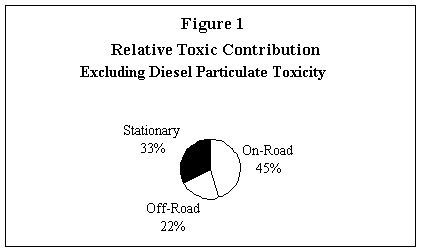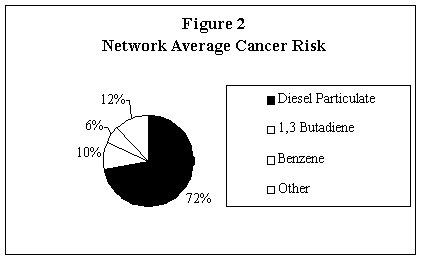![]()
BOARD MEETING DATE: September 10, 1999 AGENDA NO. 38
PROPOSAL:
Report on Proposed Air Toxics Control Plan
SYNOPSIS:
To fully implement the intent of Environmental Justice Initiative #10, staff is proposing the development of an Air Toxics Control Plan, a comprehensive short- and long-term control strategy which will outline efforts to reduce air toxic exposures in the Basin. The plan will address current air toxic levels, control strategies, and projected future air toxic emission levels.
COMMITTEE:
Stationary Source, August 20, 1999 and Mobile Source Committee, August 27, 1999, Reviewed
RECOMMENDED ACTION:
Approve the attached resolution, directing staff to proceed to develop an Air Toxics Control Plan.
Barry R. Wallerstein, D.Env.
Executive Officer
Background
On October 10, 1997, the South Coast Air Quality Management District (AQMD) Governing Board adopted ten Environmental Justice Initiatives. Environmental Justice Initiative #10 directed staff to "reopen for public comment the toxics significance thresholds for cancer and non-cancer impacts contained in Rule 1402 – Control of Toxic Air Contaminants from Existing Sources, and consideration of adding additional compounds and non-carcinogenic impact prevention into Rule 1401 – New Source Review of Toxic Air Contaminants." The AQMD Governing Board has revised Rule 1401 several times over the past year to add more toxic compounds and to address non-cancer health impacts.
AQMD staff has also worked with industry, environmental groups, local government, other agencies and the public on other possible mechanisms to address cumulative or localized toxic impacts. From these efforts, as well as the Multiple Air Toxics Exposure Study (MATES) II Study, it has become clear that there is no single measure to address cumulative impacts. Rather, a systematic and integrated approach similar to that conducted for criteria pollutants (e.g. ozone or particulates) is needed for air toxics.
Data from the MATES II best illustrates this point. This extensive study includes ambient monitoring, emission inventory, and modeling/risk assessment elements to estimate exposures to air toxics in the Basin. Preliminary data from this study were reported to the Board on March 12, 1999. Estimated risk levels in the Basin from ambient monitoring data are approximately 400 in a million without consideration of diesel emissions. Approximately 2/3 of the risk is driven by mobile sources (see Figure 1). A final report to the Board is scheduled for November 1999. Diesel emissions are expected to significantly increase the overall risk to approximately 1,500 in one million, becoming the single largest contributor to the overall risk (see Figure 2). Current over risk levels, however, are significantly reduced from 10 years ago.


As a result of discussions at the 1401/1402 working group that reducing toxics from stationary sources alone will not be sufficient, staff recommends development of a comprehensive air toxics control plan because:
Proposal
Staff is proposing development of a comprehensive Air Toxics Control Plan which would include baseline toxics information, control strategy proposals to provide further air toxic emission reductions and forecast future toxics levels. The plan will include mechanisms to integrate existing and projected federal, state and local programs.
Staff has prepared an outline of the Air Toxics Control Plan (Attachment A) which will include short- and long-term control strategies to reduce the health impact of TACs. Development of the mobile source component of the plan will be closely coordinated with U.S. EPA and the California Air Resources Board (CARB). Short-term measures will encompass early action measures and other ongoing efforts, such as changes to Rule 1402. Long-term measures may rely on the advancement or transfer-to-market of technologies and control methods. The plan will include toxic emission reduction measures based on the availability and potential development of technology and economic feasibility considerations.
Further reductions of TAC health impacts may also include additional outreach and education efforts, and opportunities for enhanced public participation. Control strategies will include mobile (including diesel) and stationary (point and area) sources. Control proposals may be recommended for all levels of government, including federal agencies, CARB, the AQMD and local governments.
Process and Schedule
The process will include numerous opportunities for public input, with an attempt to increase participation from small businesses, communities and cities. Staff will also work with the existing AQMP working group as the main forum on this project due to potential overlap with criteria pollutant control programs and broad based membership that exists in the working group. Periodic updates will also be provided to other AQMD working groups as appropriate. Workshops, noticed to all interested parties, will be held to solicit industry and community input. In addition, monthly reports will be made to the Board’s Stationary and Mobile Source Committees. Depending on future obligations, it is staff’s intent to return to the Board within six months with the comprehensive Air Toxics Control Plan.
Recommendation
Staff recommends that the Board approve the development of an Air Toxics Control Plan in concept and for subsequent consideration of adoption. The plan will be developed in a manner sensitive to protecting public health, identifying viable controls, considering technical and economic feasibility, minimizing the impacts on permit streamlining, businesses, and other resources, and providing the public with the opportunity for meaningful input and participation.
A. Outline for Air Toxics Control Plan
B. Resolution
/ / /